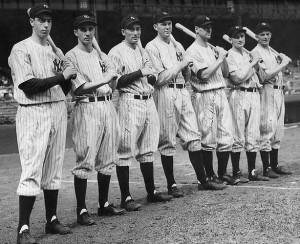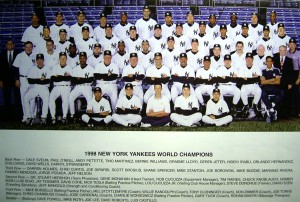
History and legacy can be a large part of identity
When you think of a baseball team, do you think of the players that are currently on the team, the coaching staff, historical teams and records, or inanimate things such as the stadium and uniforms? There is no right or wrong answer, and what comes to mind is up to an individual person and what they view as the “team”.
Teams are made up of 25 players on a year to year basis, with added roster spots late in the season. This makes it difficult to even associate particular players as being part of the team identity. The Boston Red Sox, for example, had a rookie call-up in Xander Bogaerts who only played in a handful of games during the regular season but was a major contributor in the playoffs en route to Boston winning the World Series. But was he part of the 2013 Boston Red Sox team? You could argue that he was since he was on the roster, but you could also argue against it in the fact that he wasn’t statistically eligible among active players and was only a minor factor in the overall season.
There is also the fact that teams trade players during the season and new players are added on to the roster throughout the year. When a team such as the Minnesota Twins gets rid of Justin Morneau after the all-star break, is he considered part of the 2013 team? Again, there is the argument that he is part of that team since he spent the majority of the season with his ball club, in addition to the fact that he has been with them for many years and established himself within the organization over a period of time. On the flip side, you could say that he wasn’t a member of that team since he did not finish out the season and was a contribution to another team who eventually reached the playoffs (the Pittsburgh Pirates). It is tough to consider Morneau a member of the 2013 Twins when he was playing for the Pirates in the post season that year.
While those are examples based on individual seasons, you can also look at teams as a whole over the course of their history. Players on the New York Yankees in 1970 were different from those in 1980, versus those in 1990 and so on. Yet, the New York Yankees were still the New York Yankees. Because there is such a big turnover in players from year to year and over time, it is impossible to associate a team with one particular identity. Long tenured teams like the Yankees might be an exception since there are legends that you typically associate with a given team. Babe Ruth, Mickey Mantle, Joe DiMaggio, and Yogi Berra are all highly considered legendary and lifetime Yankees whom you can associate the team with. Even Babe Ruth was once a member of the Boston Red Sox though, so Red Sox fans may think of Babe Ruth as part of their team identity. You can see the struggle in that there is no clear cut answer of a team’s identity.

The Yankees have always been thought of as championship contenders
Coaches are the same way as players in that they too can leave at any given time or be fired. If a coach who is very flamboyant and likes to wear his emotions on his sleeve is let go, and a new coach comes in who is more laid back and doesn’t want attention on himself, is there a new team identity? For that particular season there is in terms of attitude and representation of a ball club, but the overall representation is hard to change from year to year. Coaches and managers can be critical parts of a team’s success or failure, but they do not play the game and cannot physically impact the outcome. There are managerial moves for sure in making the batting order and deciding how and when to use the bullpen, but only managers that have a long history with a team can really be considered part of that team’s identity. I would argue that players are a much bigger factor in this discussion and are weighted much higher.
If the Chicago Cubs come to mind, one of the first things you might think about is Wrigley Field. How can this be if Wrigley is only a stadium where the Cubs happen to play home games? The field itself doesn’t pitch or hit or win or lose ball games. Unless a ball was to get lost in the ivy on the wall, the field is only a venue that temporarily hosts a game. When that temporary venue is as old as Wrigley Field is, it can become part of the team just as much, if not more, than any player or coach that ever donned a Cubs jersey. This is why you associate Wrigley Field with the Cubs, and probably always will, even if they replace it with a new ball park in the future.
Despite the age of any given stadium, it can still be a part of a team’s identity. Teams may sign certain players to take advantage of their home ball park, such as the Yankees signing left-handed power hitters to hit home runs with a short right field fence. This means that the stadium can in fact have an impact on the team itself and how a team is shaped from year to year.
Fans could be considered the biggest or the smallest facet of a team’s identity. Obviously, fans don’t play the game. They never step on the field to make a play, and if they do they are arrested. They never get paid to wear a uniform and many times actually pay the team for a non-authentic jersey. Fans do provide the money to pay for players, coaches, and stadiums, although much of that profit is more so for the owner than for the budget of the team. Buying a hot dog at every game for a season isn’t going to persuade an owner to go out and buy the best free agent on the market.
Identity includes more than the players
Of course, any given hardcore fan would argue that they are, in fact, part of the team and part of the team’s identity. Baseball, and professional sports in general, wouldn’t be where it is today without the support of a fan base with paying customers coming to watch the games. Whether you pay for a ticket or watch games on television, fans are the reason that athletes are paid so much when there is a vast amount of advertising to be given to the fans. While that is the business side, the personal side is the fact that a person can be a lifelong fan of a team and know everything there is to know about a team. Fans aren’t paid salaries, cut from rosters, or traded away. Fans don’t retire. They always have been, and always will be there. This is what makes up an identity of a team.

High expectations can establish the look and feel of a team over the years
Another thought about how to identify a team is how they look. When the Florida Marlins changed their name to the Miami Marlins, switched uniforms, and had a new stadium, were they really a brand new team? When the Montreal Expos moved to Washington DC and became the Nationals, did that give them a new identity? In the Marlins example, no it did not. In the Nationals example, it could be argued that it did. The Marlins have continued to struggle and have had the same predicted outcome weather they were the Florida Marlins or the Miami Marlins. The Nationals have become a contender after having one of the worst franchises in all of sports when they were located north of the border. Time and place can be a factor, but again it comes down to the players and how they perform on the field.
Can a team be identified on a year to year basis? Of course they can. Building a team identity is part of every coach or manager’s agenda each season. In order to compete, they have to find out what kind of team they have. Establishing a team’s identity over the course of a decade can be done if there is consistency within an organization, but finding an identity over the course of history can be a daunting task.
The Yankees probably have the most iconic identity in terms of winning. They were contenders in the past, are contenders in the present, and will be contenders in the future. A team like the Red Sox had an identity of overcoming, as they tried for so long to break the curse of the Bambino. Now that they have done that repeatedly, their identity isn’t as clear anymore. Younger teams like Arizona and Tampa Bay do not have enough history to have a true team identity over the course of their existence. The organizations that can establish a year to year identity can ultimately define themselves in the long term, something that takes more than one year to accomplish.

Leave a Reply